Watched December 3-9, 2007: Sjöström, Mizoguchi, Kurosawa, Shostakovich's Mouse and Aoi Miyazaki
Terje Vigen (Victor Sjöström, 1917)
 A lovely (and visually remarkable) film, based on a narrative poem by the Norwegian dramatist Henrik Ibsen. The poem tells of Terje Vigen, a sailor who tries to run a British blockade (in 1809) in order to get food for his wife and infant, is captured by the British and imprisoned for five years,
A lovely (and visually remarkable) film, based on a narrative poem by the Norwegian dramatist Henrik Ibsen. The poem tells of Terje Vigen, a sailor who tries to run a British blockade (in 1809) in order to get food for his wife and infant, is captured by the British and imprisoned for five years, 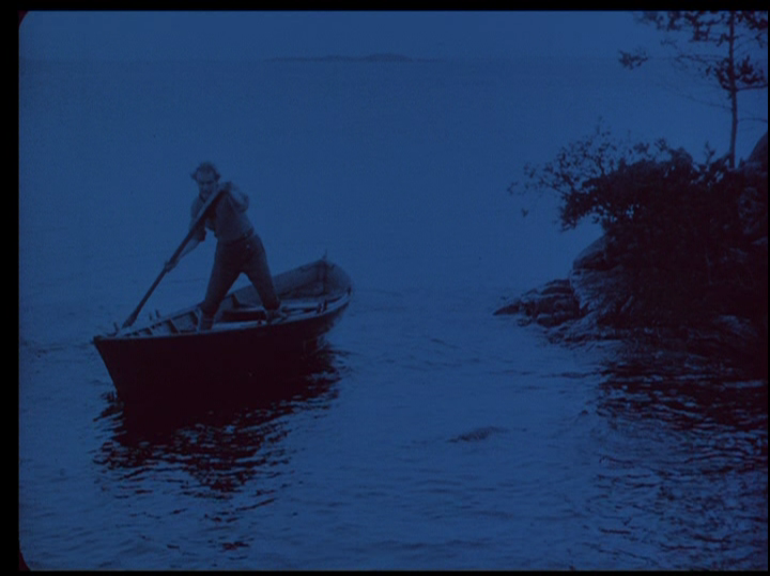 and returns home only to find his wife and child have died. Working as a ship's pilot off southern Norway, he is one day called on to rescue the yacht of an English lord (who turns out tho be the ship's captain who captured him), traveling with his wife and child. On recognizing his tormentor, Vigen initially plans to sink the ship with all aboard, but on looking at the child, relents.
and returns home only to find his wife and child have died. Working as a ship's pilot off southern Norway, he is one day called on to rescue the yacht of an English lord (who turns out tho be the ship's captain who captured him), traveling with his wife and child. On recognizing his tormentor, Vigen initially plans to sink the ship with all aboard, but on looking at the child, relents. 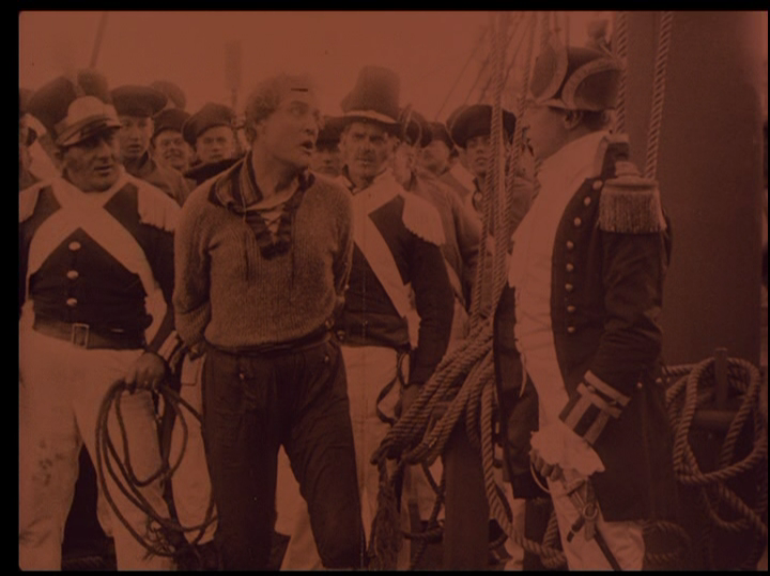 Unlike most of Ibsen's work, this poem is unabashedly sentimental, with not even the tiniest trace of irony. Sjöström's film seems to follow the plot of the poem pretty faithfully (and the intertitles are based on the poem), though Vigen's prison seems to be land-based, as opposed to the prison barge specified in the poem.
Unlike most of Ibsen's work, this poem is unabashedly sentimental, with not even the tiniest trace of irony. Sjöström's film seems to follow the plot of the poem pretty faithfully (and the intertitles are based on the poem), though Vigen's prison seems to be land-based, as opposed to the prison barge specified in the poem.
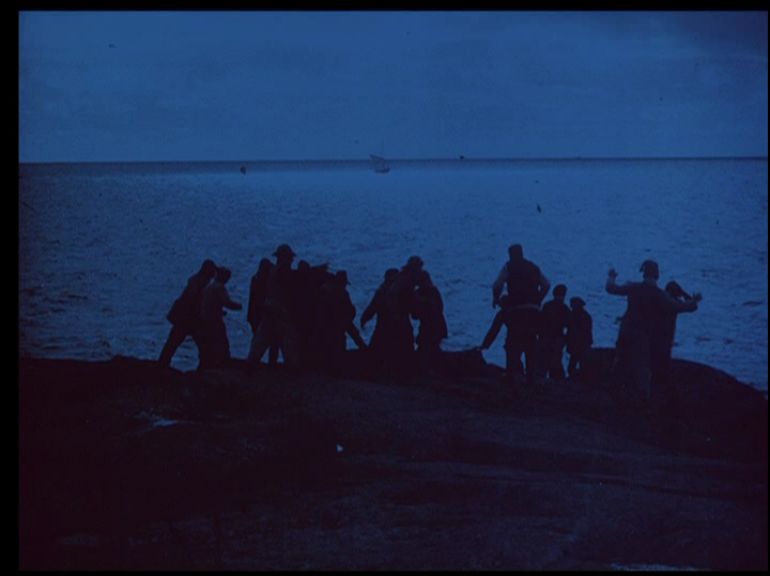 Sjöström not only directs here, he also plays Vigen. His acting style is fairly broad and "old-fashioned", but vigorous and effective. Other cast members have relatively little to do in comparison. The work of German Romantic painter Caspar David Friedrich
Sjöström not only directs here, he also plays Vigen. His acting style is fairly broad and "old-fashioned", but vigorous and effective. Other cast members have relatively little to do in comparison. The work of German Romantic painter Caspar David Friedrich 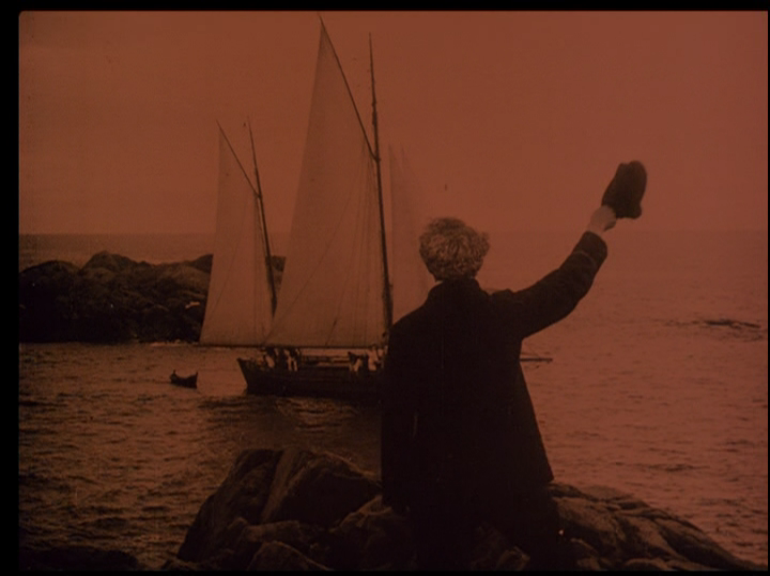 would seem to have had a lot of influence on Sjöström's scenic composition. The cinematography is generally simple but attractive. However, it rises to a higher level when capturing (and bringing to life) the sea (the only element in the film as important as Terje Vigen himself).
would seem to have had a lot of influence on Sjöström's scenic composition. The cinematography is generally simple but attractive. However, it rises to a higher level when capturing (and bringing to life) the sea (the only element in the film as important as Terje Vigen himself).
More pictures:
http://i9.photobucket.com/albums/a59/mkerpan/dec_07/terje/vigen02.png
http://i9.photobucket.com/albums/a59/mkerpan/dec_07/terje/vigen03.png
http://i9.photobucket.com/albums/a59/mkerpan/dec_07/terje/vigen04.png
http://i9.photobucket.com/albums/a59/mkerpan/dec_07/terje/vigen06.png
http://i9.photobucket.com/albums/a59/mkerpan/dec_07/terje/vigen08.png
http://i9.photobucket.com/albums/a59/mkerpan/dec_07/terje/vigen10.png
Tokyo koshin-kyoku / Tokyo March (Kenji Mizoguchi, 1929)
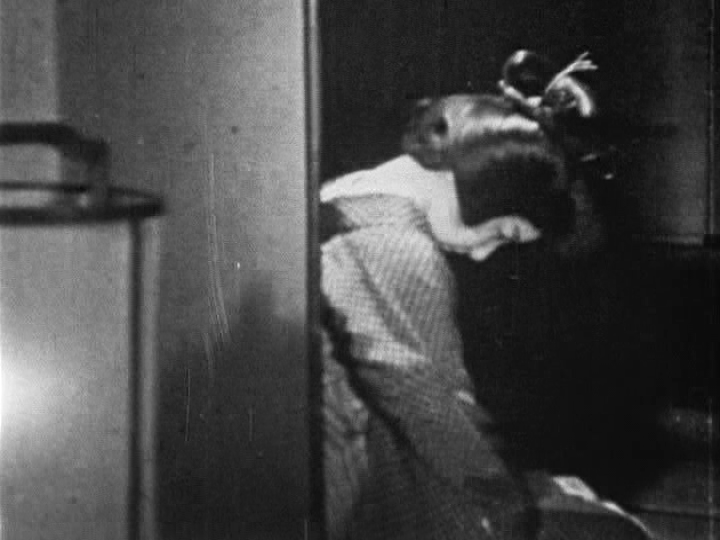 One of the earliest of Mizoguchi's few surviving silent films (out of the 70 or so he made). Alas, this exists in only an incomplete condensed version (preserving a bit more than 20 minutes, out of the original 90 or so minutes).
One of the earliest of Mizoguchi's few surviving silent films (out of the 70 or so he made). Alas, this exists in only an incomplete condensed version (preserving a bit more than 20 minutes, out of the original 90 or so minutes).  Apparently, the film had several parallel threads about life in 1920s Tokyo, but the condensed version preserves only highlights of one of the story threads (Takako Irie, one of the film's stars appears only briefly and peripherally in the preserved remnant).
Apparently, the film had several parallel threads about life in 1920s Tokyo, but the condensed version preserves only highlights of one of the story threads (Takako Irie, one of the film's stars appears only briefly and peripherally in the preserved remnant).
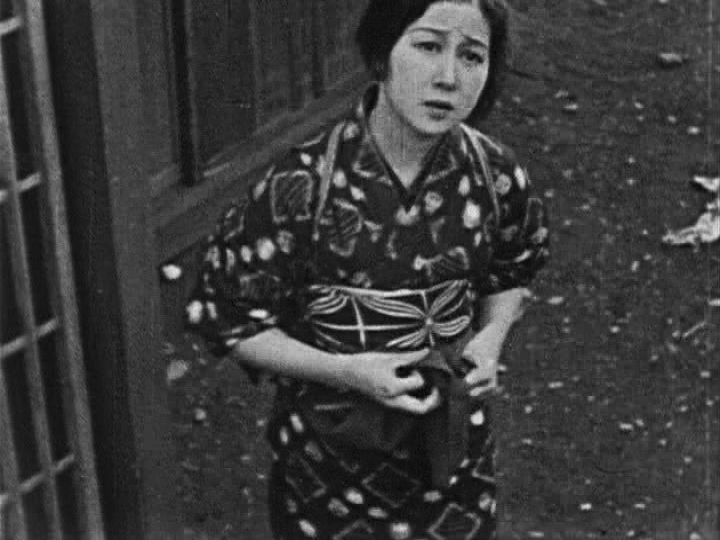 The story that remains concerns a young woman living with her aunt and uncle (after the death of her mother, who had been a geisha). All she has to remember her mother by is a ring that was passed on to her -- and she never knew her father at all. In order to not be a burden on her far from affluent relatives, the young woman also goes to work as a geisha.
The story that remains concerns a young woman living with her aunt and uncle (after the death of her mother, who had been a geisha). All she has to remember her mother by is a ring that was passed on to her -- and she never knew her father at all. In order to not be a burden on her far from affluent relatives, the young woman also goes to work as a geisha.  One day she meets a couple of young men, when she tries to help them retrieve an errant tennis ball (and charms them both). In her professional capacity, she also catches the attention of the wealthy father of one of the young men. She and the man's son fall in love, but the (unwitting) father still pursues the girl himself.
One day she meets a couple of young men, when she tries to help them retrieve an errant tennis ball (and charms them both). In her professional capacity, she also catches the attention of the wealthy father of one of the young men. She and the man's son fall in love, but the (unwitting) father still pursues the girl himself. 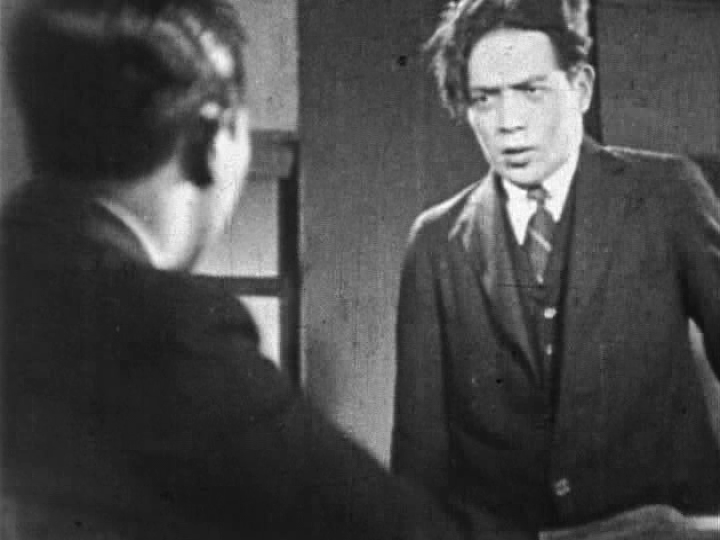 When trying to gain her favor, he sees the ring she wears -- and realizes she is his own (illegitimate) daughter. Obviously, this puts a crimp in the romance of the two young people. Luckily for her, the other young man adores her too -- and the brother goes off to America to try to forget his sorrows.
When trying to gain her favor, he sees the ring she wears -- and realizes she is his own (illegitimate) daughter. Obviously, this puts a crimp in the romance of the two young people. Luckily for her, the other young man adores her too -- and the brother goes off to America to try to forget his sorrows.
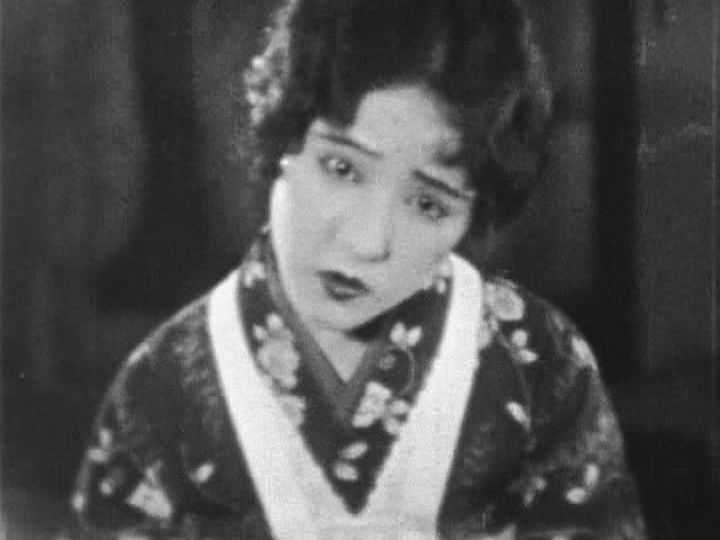 The remains of this film are intriguing. The editing is far more "vigorous" than one is used to in later Mizoguchi films (even the 30s silents), but the composition of scenes often prefigures that found in later works. This film is actually a bonus feature on Digital Meme's new subbed, benshi-narrated release of Mizoguchi's Taki no shiraito (The Water Magician).
The remains of this film are intriguing. The editing is far more "vigorous" than one is used to in later Mizoguchi films (even the 30s silents), but the composition of scenes often prefigures that found in later works. This film is actually a bonus feature on Digital Meme's new subbed, benshi-narrated release of Mizoguchi's Taki no shiraito (The Water Magician).  Tokyo March is not only narrated by Midori Sawato (both today's leading benshi and teacher of film narration), she also sings (very well) the song intended to accompany the opening (and close) of the film. One can only hope that Digital Meme will eventually release many more "silent" (or, better, "pre-talkie") Japanese treasures.
Tokyo March is not only narrated by Midori Sawato (both today's leading benshi and teacher of film narration), she also sings (very well) the song intended to accompany the opening (and close) of the film. One can only hope that Digital Meme will eventually release many more "silent" (or, better, "pre-talkie") Japanese treasures.
More screen shots:
http://i9.photobucket.com/albums/a59/mkerpan/mizoguchi/march/tm01.png
http://i9.photobucket.com/albums/a59/mkerpan/mizoguchi/march/tm03.png
http://i9.photobucket.com/albums/a59/mkerpan/mizoguchi/march/tm04.png
http://i9.photobucket.com/albums/a59/mkerpan/mizoguchi/march/tm10.png
Skazka o glupom myshonke / The Tale of the Silly Little Mouse (Mikhail Tsekhanovsky, 1940)
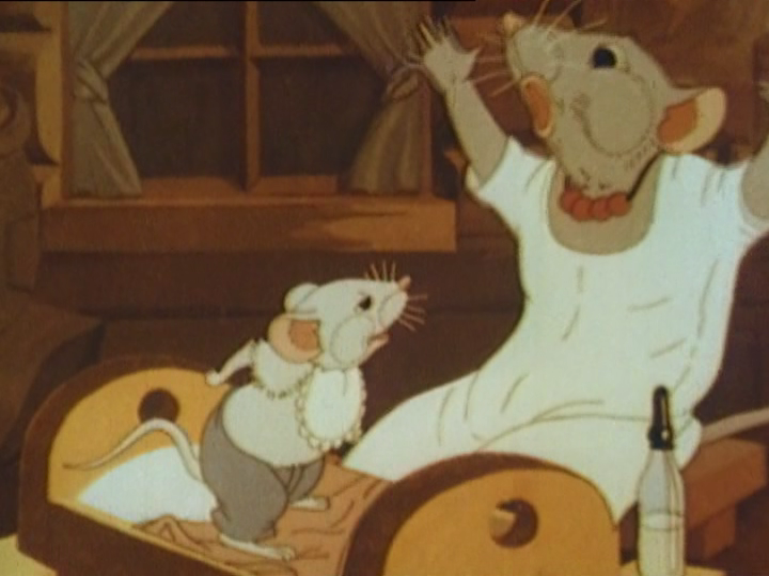 My main interest here was the musical score -- in essence a little chamber opera for children by Dmitri Shostakovich, based on a folk tale (as retold by great poet Samuel Marshak). But, as it turned out, t
My main interest here was the musical score -- in essence a little chamber opera for children by Dmitri Shostakovich, based on a folk tale (as retold by great poet Samuel Marshak). But, as it turned out, t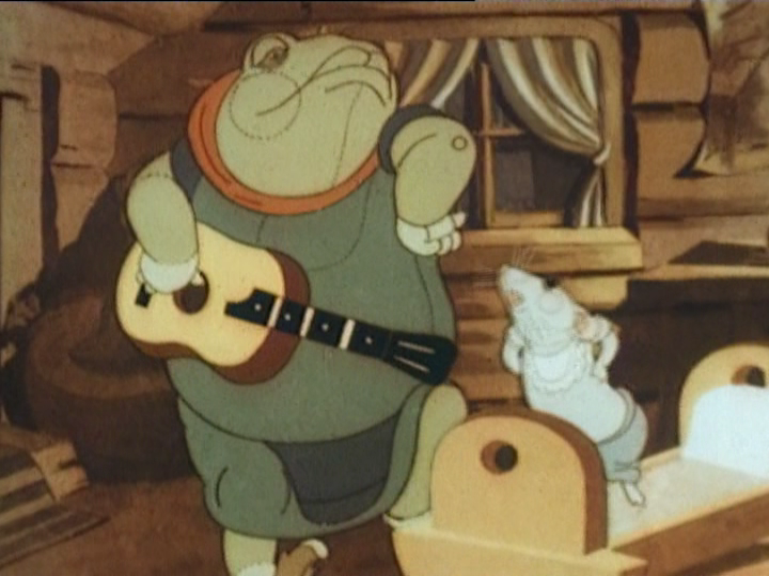 his tale of naughty baby mouse who doesn't want to go to sleep at bedtime was a visual treat as well. Mama Mouse calls on various neighbors -- a duck, a pig, a frog, a horse, a sturgeon (!) and (unwisely) a cat -- to coax her child to sleep.
his tale of naughty baby mouse who doesn't want to go to sleep at bedtime was a visual treat as well. Mama Mouse calls on various neighbors -- a duck, a pig, a frog, a horse, a sturgeon (!) and (unwisely) a cat -- to coax her child to sleep. 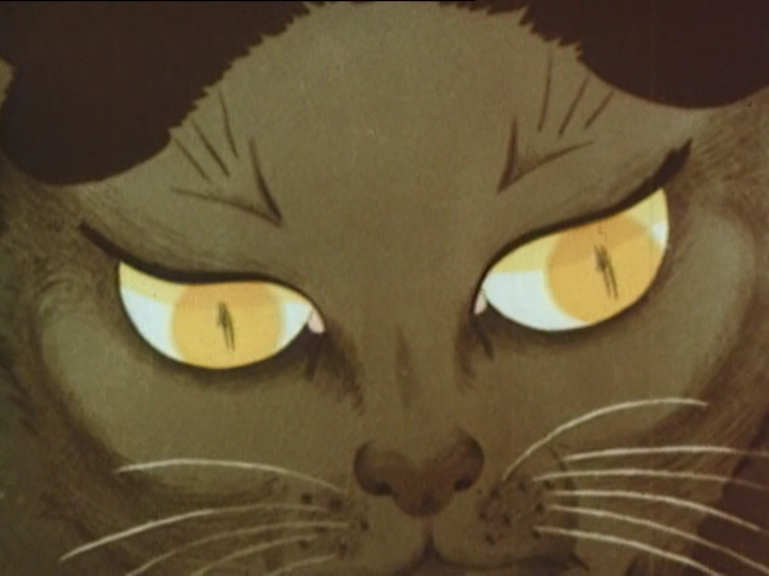 Not to worry, the good-hearted (but not terribly observant) neighborhood watch dog comes to the rescue in time. This cartoon came as a bonus on the (German) Absolut Media DVD of Kozintsev and Trauberg's Odna (Alone). Unlike the main feature, this is neither restored nor subtitled -- but it is still a nice extra treat.
Not to worry, the good-hearted (but not terribly observant) neighborhood watch dog comes to the rescue in time. This cartoon came as a bonus on the (German) Absolut Media DVD of Kozintsev and Trauberg's Odna (Alone). Unlike the main feature, this is neither restored nor subtitled -- but it is still a nice extra treat.
More pictures:
http://i9.photobucket.com/albums/a59/mkerpan/dec_07/silly/mouse01.png
http://i9.photobucket.com/albums/a59/mkerpan/dec_07/silly/mouse02.png
http://i9.photobucket.com/albums/a59/mkerpan/dec_07/silly/mouse04.png
http://i9.photobucket.com/albums/a59/mkerpan/dec_07/silly/mouse05.png
http://i9.photobucket.com/albums/a59/mkerpan/dec_07/silly/mouse07.png
http://i9.photobucket.com/albums/a59/mkerpan/dec_07/silly/mouse08.png
http://i9.photobucket.com/albums/a59/mkerpan/dec_07/silly/mouse09.png
http://i9.photobucket.com/albums/a59/mkerpan/dec_07/silly/mouse10.png
http://i9.photobucket.com/albums/a59/mkerpan/dec_07/silly/mouse11.png
http://i9.photobucket.com/albums/a59/mkerpan/dec_07/silly/mouse13.png
http://i9.photobucket.com/albums/a59/mkerpan/dec_07/silly/mouse14.png
Yoidore tenshi / Drunken Angel (Akira Kurosawa, 1948)
 The first of Kurosawa's three "doctor films" -- and (more momentously) the first appearance by Toshiro Mifune in a Kurosawa film. As in many films to come, the central relationship is that between Mifune and Takashi Shimura.
The first of Kurosawa's three "doctor films" -- and (more momentously) the first appearance by Toshiro Mifune in a Kurosawa film. As in many films to come, the central relationship is that between Mifune and Takashi Shimura. 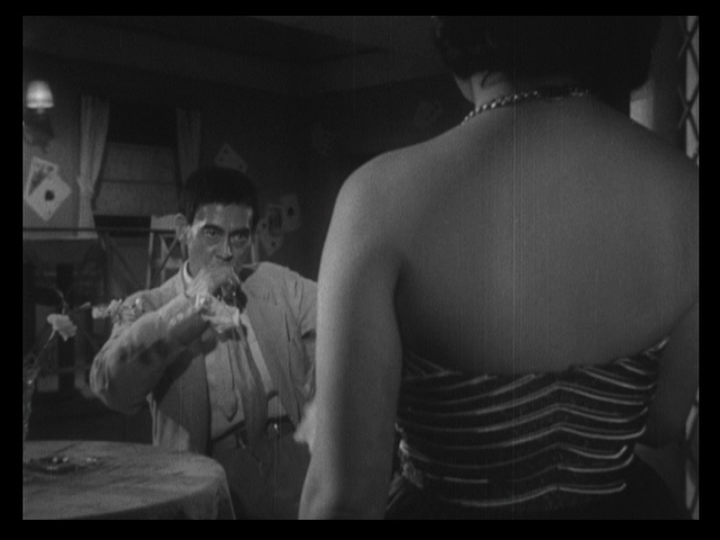 Here Mifune is a mid level gang boss and Shimura is an alcoholic doctor who tries to treat Mifune (who turns out to have tuberculosis). Mifune is not a "good patient" -- and
Here Mifune is a mid level gang boss and Shimura is an alcoholic doctor who tries to treat Mifune (who turns out to have tuberculosis). Mifune is not a "good patient" -- and 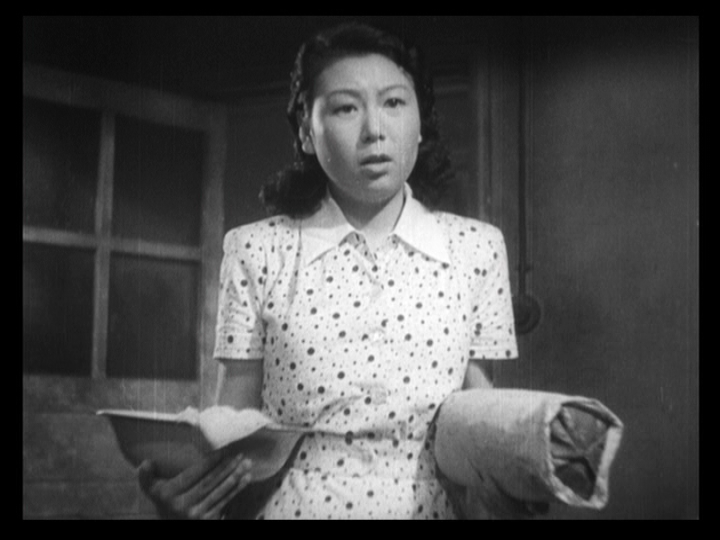 Shimura's resentment of gangsters doesn't make the doctor-patient relationship any easier. Mifune's situation takes a turn for the worse, when his former superior is released from prison -- and wants not only his former place back but also Mifune's girl friend (Michiyo Kogure).
Shimura's resentment of gangsters doesn't make the doctor-patient relationship any easier. Mifune's situation takes a turn for the worse, when his former superior is released from prison -- and wants not only his former place back but also Mifune's girl friend (Michiyo Kogure).  The boss also is vexed that his former girl friend (Chieko Nakakita) is under Shimura's protection, working as a nurse. Meanwhile, a spunky barkeeper's assistant (Noriko Sengoku) who loves Mifune wants him to flee with her to her family's farm (so he can recover -- and escape gang life). Shimura does have other TB patients -- including young Yoshiko Kuga, who IS a good patient, well on her way to recovery.
The boss also is vexed that his former girl friend (Chieko Nakakita) is under Shimura's protection, working as a nurse. Meanwhile, a spunky barkeeper's assistant (Noriko Sengoku) who loves Mifune wants him to flee with her to her family's farm (so he can recover -- and escape gang life). Shimura does have other TB patients -- including young Yoshiko Kuga, who IS a good patient, well on her way to recovery.
 The acting style of Mifune and Shimura and the gang boss (Reisaburo Yamamoto) is often intense, on or over the edge of over-acting at times. On the other hand, the performances of the important female characters
The acting style of Mifune and Shimura and the gang boss (Reisaburo Yamamoto) is often intense, on or over the edge of over-acting at times. On the other hand, the performances of the important female characters  (all the above, plus Choko Iida as Shimura's maid) are typically more restrained (and natural seeming). The film feels a bit didactic at times, and the plotting a bit schematic. But the visual images are outstanding.
(all the above, plus Choko Iida as Shimura's maid) are typically more restrained (and natural seeming). The film feels a bit didactic at times, and the plotting a bit schematic. But the visual images are outstanding. 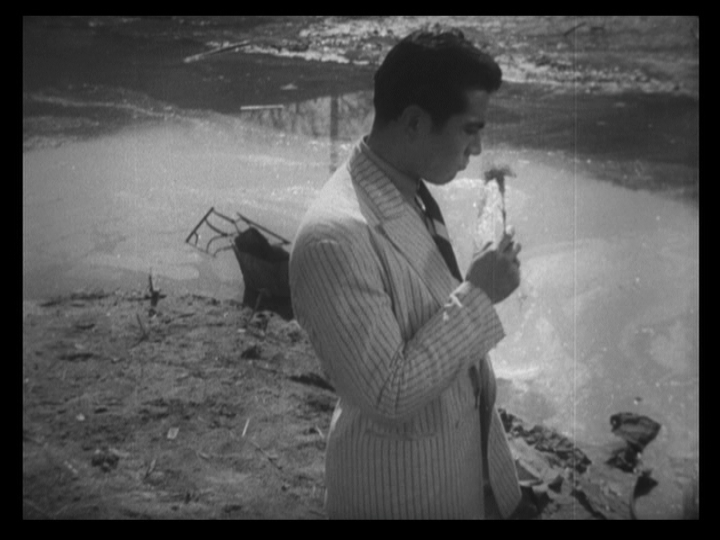 A very good film -- but I don't see it as a radical advance from No Regrets for Our Youth (as critical consensus would have it), but rather just an incremental step. The new Criterion DVD probably makes this look (and sound) about as good as currently possible.
A very good film -- but I don't see it as a radical advance from No Regrets for Our Youth (as critical consensus would have it), but rather just an incremental step. The new Criterion DVD probably makes this look (and sound) about as good as currently possible.
Showing off more wonderful moments of this visually striking film:
http://i9.photobucket.com/albums/a59/mkerpan/kurosawa/drunken/angel03.png
http://i9.photobucket.com/albums/a59/mkerpan/kurosawa/drunken/angel04.png
http://i9.photobucket.com/albums/a59/mkerpan/kurosawa/drunken/angel05.png
http://i9.photobucket.com/albums/a59/mkerpan/kurosawa/drunken/angel06.png
http://i9.photobucket.com/albums/a59/mkerpan/kurosawa/drunken/angel08.png
http://i9.photobucket.com/albums/a59/mkerpan/kurosawa/drunken/angel10.png
http://i9.photobucket.com/albums/a59/mkerpan/kurosawa/drunken/angel14.png
http://i9.photobucket.com/albums/a59/mkerpan/kurosawa/drunken/angel15.png
http://i9.photobucket.com/albums/a59/mkerpan/kurosawa/drunken/angel16.png
http://i9.photobucket.com/albums/a59/mkerpan/kurosawa/drunken/angel17.png
http://i9.photobucket.com/albums/a59/mkerpan/kurosawa/drunken/angel18.png
http://i9.photobucket.com/albums/a59/mkerpan/kurosawa/drunken/angel19.png
http://i9.photobucket.com/albums/a59/mkerpan/kurosawa/drunken/angel20.png
Tada, kimi wo aishiteru / Heavenly Forest (Takehiko Shinjo, 2006)
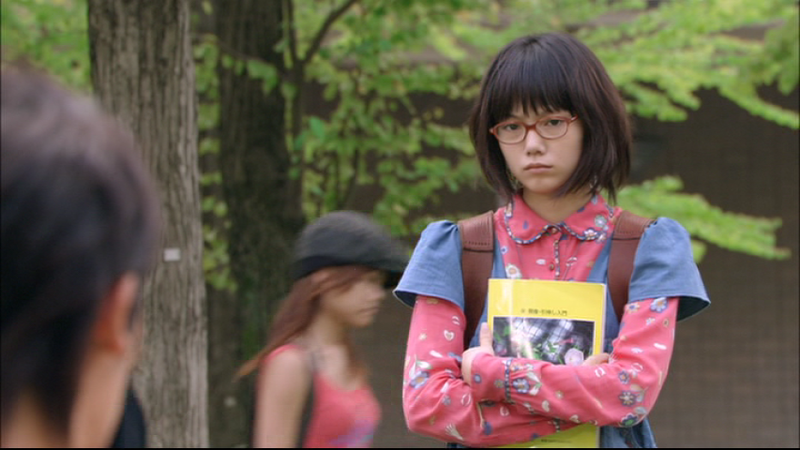 Aoi Miyazaki and Hiroshi Tamaki are college classmates, both a little bit nerdy. Tamaki is interested in photography, so Miyazaki takes this hobby up as well. Miyazaki obviously has a crush on Tamaki,
Aoi Miyazaki and Hiroshi Tamaki are college classmates, both a little bit nerdy. Tamaki is interested in photography, so Miyazaki takes this hobby up as well. Miyazaki obviously has a crush on Tamaki, 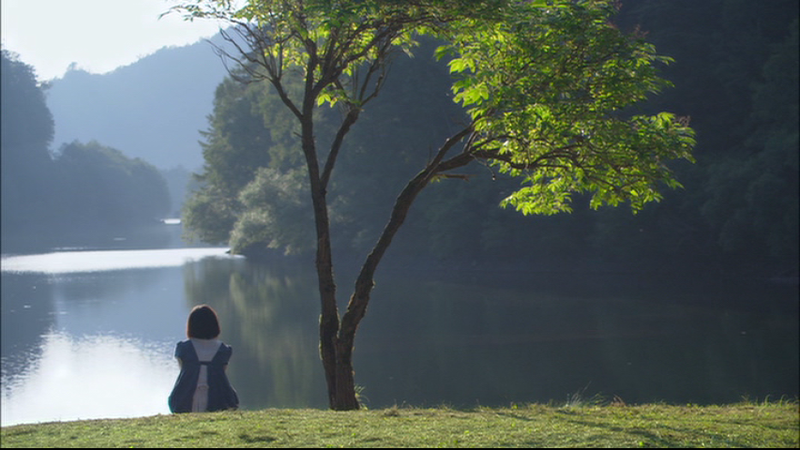 but he is more interested in a more conventional (and popular) classmate (Meisa Kuroki). After arranging for a first kiss (photographed) from Tamaki, Miyazaki disappears. A few years later, Tamaki is invited to the opening of Miyazaki's first photo exhibition. What will he find there?
but he is more interested in a more conventional (and popular) classmate (Meisa Kuroki). After arranging for a first kiss (photographed) from Tamaki, Miyazaki disappears. A few years later, Tamaki is invited to the opening of Miyazaki's first photo exhibition. What will he find there?
This sentimental romance has a decent enough premise, but is not structured very well.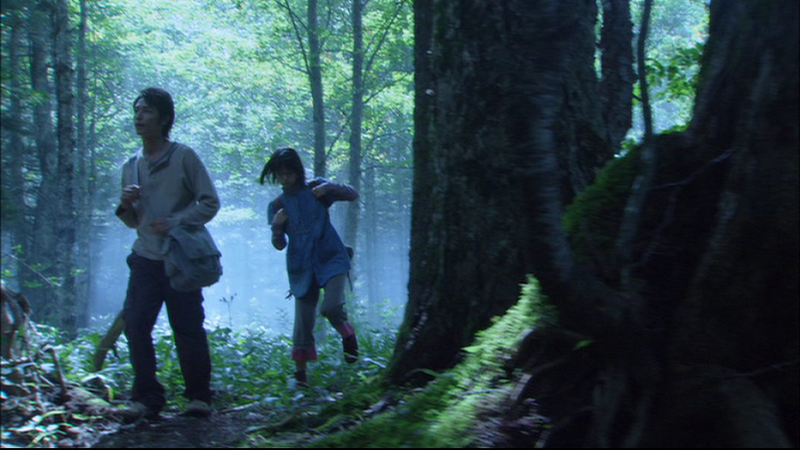 The cinematography is rather pedestrian -- rather ironically, given that this is a film about photography. Tamaki and Kuroki perfgorm passably, but neither is in the same league as Aoi Miyazaki -- one of the two most promising young actresses of Japan (the other being Chizuru Ikewaki). Miyazaki made a tremendous impression as a child actress, in a virtually silent performance in Aoyama's Eureka, which was followed by her wrenching performance in Shiota's Gaichu (Harmful Insect). Just recently married, she is still negotiating the difficult transition from child star to top level adult professional.
The cinematography is rather pedestrian -- rather ironically, given that this is a film about photography. Tamaki and Kuroki perfgorm passably, but neither is in the same league as Aoi Miyazaki -- one of the two most promising young actresses of Japan (the other being Chizuru Ikewaki). Miyazaki made a tremendous impression as a child actress, in a virtually silent performance in Aoyama's Eureka, which was followed by her wrenching performance in Shiota's Gaichu (Harmful Insect). Just recently married, she is still negotiating the difficult transition from child star to top level adult professional. 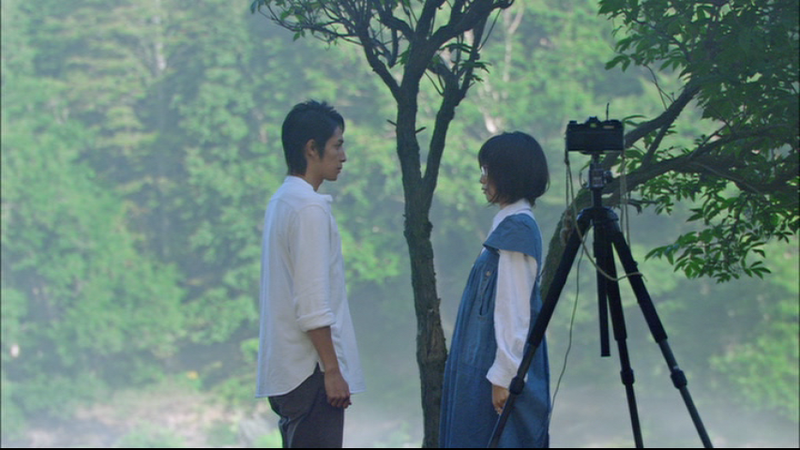 First known for her expertise in handling somber (even sad) characters, she has begun to hone her comic skills (viz. Nana). she manages to handle a blend of mild comedy and sadness here. Miyazaki's fans and well-wishers will find this relatively minor romance worth seeing, and others might find it mildly diverting (and find themselves charmed by Miyazaki's gawky heroine).
First known for her expertise in handling somber (even sad) characters, she has begun to hone her comic skills (viz. Nana). she manages to handle a blend of mild comedy and sadness here. Miyazaki's fans and well-wishers will find this relatively minor romance worth seeing, and others might find it mildly diverting (and find themselves charmed by Miyazaki's gawky heroine).
A few more shots:
http://i9.photobucket.com/albums/a59/mkerpan/dec_07/hf/tada01.png
http://i9.photobucket.com/albums/a59/mkerpan/dec_07/hf/tada03.png
http://i9.photobucket.com/albums/a59/mkerpan/dec_07/hf/tada07.png
http://i9.photobucket.com/albums/a59/mkerpan/dec_07/hf/tada08.png
 A lovely (and visually remarkable) film, based on a narrative poem by the Norwegian dramatist Henrik Ibsen. The poem tells of Terje Vigen, a sailor who tries to run a British blockade (in 1809) in order to get food for his wife and infant, is captured by the British and imprisoned for five years,
A lovely (and visually remarkable) film, based on a narrative poem by the Norwegian dramatist Henrik Ibsen. The poem tells of Terje Vigen, a sailor who tries to run a British blockade (in 1809) in order to get food for his wife and infant, is captured by the British and imprisoned for five years,  and returns home only to find his wife and child have died. Working as a ship's pilot off southern Norway, he is one day called on to rescue the yacht of an English lord (who turns out tho be the ship's captain who captured him), traveling with his wife and child. On recognizing his tormentor, Vigen initially plans to sink the ship with all aboard, but on looking at the child, relents.
and returns home only to find his wife and child have died. Working as a ship's pilot off southern Norway, he is one day called on to rescue the yacht of an English lord (who turns out tho be the ship's captain who captured him), traveling with his wife and child. On recognizing his tormentor, Vigen initially plans to sink the ship with all aboard, but on looking at the child, relents.  Unlike most of Ibsen's work, this poem is unabashedly sentimental, with not even the tiniest trace of irony. Sjöström's film seems to follow the plot of the poem pretty faithfully (and the intertitles are based on the poem), though Vigen's prison seems to be land-based, as opposed to the prison barge specified in the poem.
Unlike most of Ibsen's work, this poem is unabashedly sentimental, with not even the tiniest trace of irony. Sjöström's film seems to follow the plot of the poem pretty faithfully (and the intertitles are based on the poem), though Vigen's prison seems to be land-based, as opposed to the prison barge specified in the poem. Sjöström not only directs here, he also plays Vigen. His acting style is fairly broad and "old-fashioned", but vigorous and effective. Other cast members have relatively little to do in comparison. The work of German Romantic painter Caspar David Friedrich
Sjöström not only directs here, he also plays Vigen. His acting style is fairly broad and "old-fashioned", but vigorous and effective. Other cast members have relatively little to do in comparison. The work of German Romantic painter Caspar David Friedrich  would seem to have had a lot of influence on Sjöström's scenic composition. The cinematography is generally simple but attractive. However, it rises to a higher level when capturing (and bringing to life) the sea (the only element in the film as important as Terje Vigen himself).
would seem to have had a lot of influence on Sjöström's scenic composition. The cinematography is generally simple but attractive. However, it rises to a higher level when capturing (and bringing to life) the sea (the only element in the film as important as Terje Vigen himself).More pictures:
http://i9.photobucket.com/albums/a59/mkerpan/dec_07/terje/vigen02.png
http://i9.photobucket.com/albums/a59/mkerpan/dec_07/terje/vigen03.png
http://i9.photobucket.com/albums/a59/mkerpan/dec_07/terje/vigen04.png
http://i9.photobucket.com/albums/a59/mkerpan/dec_07/terje/vigen06.png
http://i9.photobucket.com/albums/a59/mkerpan/dec_07/terje/vigen08.png
http://i9.photobucket.com/albums/a59/mkerpan/dec_07/terje/vigen10.png
Tokyo koshin-kyoku / Tokyo March (Kenji Mizoguchi, 1929)
 One of the earliest of Mizoguchi's few surviving silent films (out of the 70 or so he made). Alas, this exists in only an incomplete condensed version (preserving a bit more than 20 minutes, out of the original 90 or so minutes).
One of the earliest of Mizoguchi's few surviving silent films (out of the 70 or so he made). Alas, this exists in only an incomplete condensed version (preserving a bit more than 20 minutes, out of the original 90 or so minutes).  Apparently, the film had several parallel threads about life in 1920s Tokyo, but the condensed version preserves only highlights of one of the story threads (Takako Irie, one of the film's stars appears only briefly and peripherally in the preserved remnant).
Apparently, the film had several parallel threads about life in 1920s Tokyo, but the condensed version preserves only highlights of one of the story threads (Takako Irie, one of the film's stars appears only briefly and peripherally in the preserved remnant). The story that remains concerns a young woman living with her aunt and uncle (after the death of her mother, who had been a geisha). All she has to remember her mother by is a ring that was passed on to her -- and she never knew her father at all. In order to not be a burden on her far from affluent relatives, the young woman also goes to work as a geisha.
The story that remains concerns a young woman living with her aunt and uncle (after the death of her mother, who had been a geisha). All she has to remember her mother by is a ring that was passed on to her -- and she never knew her father at all. In order to not be a burden on her far from affluent relatives, the young woman also goes to work as a geisha.  One day she meets a couple of young men, when she tries to help them retrieve an errant tennis ball (and charms them both). In her professional capacity, she also catches the attention of the wealthy father of one of the young men. She and the man's son fall in love, but the (unwitting) father still pursues the girl himself.
One day she meets a couple of young men, when she tries to help them retrieve an errant tennis ball (and charms them both). In her professional capacity, she also catches the attention of the wealthy father of one of the young men. She and the man's son fall in love, but the (unwitting) father still pursues the girl himself.  When trying to gain her favor, he sees the ring she wears -- and realizes she is his own (illegitimate) daughter. Obviously, this puts a crimp in the romance of the two young people. Luckily for her, the other young man adores her too -- and the brother goes off to America to try to forget his sorrows.
When trying to gain her favor, he sees the ring she wears -- and realizes she is his own (illegitimate) daughter. Obviously, this puts a crimp in the romance of the two young people. Luckily for her, the other young man adores her too -- and the brother goes off to America to try to forget his sorrows. The remains of this film are intriguing. The editing is far more "vigorous" than one is used to in later Mizoguchi films (even the 30s silents), but the composition of scenes often prefigures that found in later works. This film is actually a bonus feature on Digital Meme's new subbed, benshi-narrated release of Mizoguchi's Taki no shiraito (The Water Magician).
The remains of this film are intriguing. The editing is far more "vigorous" than one is used to in later Mizoguchi films (even the 30s silents), but the composition of scenes often prefigures that found in later works. This film is actually a bonus feature on Digital Meme's new subbed, benshi-narrated release of Mizoguchi's Taki no shiraito (The Water Magician).  Tokyo March is not only narrated by Midori Sawato (both today's leading benshi and teacher of film narration), she also sings (very well) the song intended to accompany the opening (and close) of the film. One can only hope that Digital Meme will eventually release many more "silent" (or, better, "pre-talkie") Japanese treasures.
Tokyo March is not only narrated by Midori Sawato (both today's leading benshi and teacher of film narration), she also sings (very well) the song intended to accompany the opening (and close) of the film. One can only hope that Digital Meme will eventually release many more "silent" (or, better, "pre-talkie") Japanese treasures.More screen shots:
http://i9.photobucket.com/albums/a59/mkerpan/mizoguchi/march/tm01.png
http://i9.photobucket.com/albums/a59/mkerpan/mizoguchi/march/tm03.png
http://i9.photobucket.com/albums/a59/mkerpan/mizoguchi/march/tm04.png
http://i9.photobucket.com/albums/a59/mkerpan/mizoguchi/march/tm10.png
Skazka o glupom myshonke / The Tale of the Silly Little Mouse (Mikhail Tsekhanovsky, 1940)
 My main interest here was the musical score -- in essence a little chamber opera for children by Dmitri Shostakovich, based on a folk tale (as retold by great poet Samuel Marshak). But, as it turned out, t
My main interest here was the musical score -- in essence a little chamber opera for children by Dmitri Shostakovich, based on a folk tale (as retold by great poet Samuel Marshak). But, as it turned out, t his tale of naughty baby mouse who doesn't want to go to sleep at bedtime was a visual treat as well. Mama Mouse calls on various neighbors -- a duck, a pig, a frog, a horse, a sturgeon (!) and (unwisely) a cat -- to coax her child to sleep.
his tale of naughty baby mouse who doesn't want to go to sleep at bedtime was a visual treat as well. Mama Mouse calls on various neighbors -- a duck, a pig, a frog, a horse, a sturgeon (!) and (unwisely) a cat -- to coax her child to sleep.  Not to worry, the good-hearted (but not terribly observant) neighborhood watch dog comes to the rescue in time. This cartoon came as a bonus on the (German) Absolut Media DVD of Kozintsev and Trauberg's Odna (Alone). Unlike the main feature, this is neither restored nor subtitled -- but it is still a nice extra treat.
Not to worry, the good-hearted (but not terribly observant) neighborhood watch dog comes to the rescue in time. This cartoon came as a bonus on the (German) Absolut Media DVD of Kozintsev and Trauberg's Odna (Alone). Unlike the main feature, this is neither restored nor subtitled -- but it is still a nice extra treat.More pictures:
http://i9.photobucket.com/albums/a59/mkerpan/dec_07/silly/mouse01.png
http://i9.photobucket.com/albums/a59/mkerpan/dec_07/silly/mouse02.png
http://i9.photobucket.com/albums/a59/mkerpan/dec_07/silly/mouse04.png
http://i9.photobucket.com/albums/a59/mkerpan/dec_07/silly/mouse05.png
http://i9.photobucket.com/albums/a59/mkerpan/dec_07/silly/mouse07.png
http://i9.photobucket.com/albums/a59/mkerpan/dec_07/silly/mouse08.png
http://i9.photobucket.com/albums/a59/mkerpan/dec_07/silly/mouse09.png
http://i9.photobucket.com/albums/a59/mkerpan/dec_07/silly/mouse10.png
http://i9.photobucket.com/albums/a59/mkerpan/dec_07/silly/mouse11.png
http://i9.photobucket.com/albums/a59/mkerpan/dec_07/silly/mouse13.png
http://i9.photobucket.com/albums/a59/mkerpan/dec_07/silly/mouse14.png
Yoidore tenshi / Drunken Angel (Akira Kurosawa, 1948)
 The first of Kurosawa's three "doctor films" -- and (more momentously) the first appearance by Toshiro Mifune in a Kurosawa film. As in many films to come, the central relationship is that between Mifune and Takashi Shimura.
The first of Kurosawa's three "doctor films" -- and (more momentously) the first appearance by Toshiro Mifune in a Kurosawa film. As in many films to come, the central relationship is that between Mifune and Takashi Shimura.  Here Mifune is a mid level gang boss and Shimura is an alcoholic doctor who tries to treat Mifune (who turns out to have tuberculosis). Mifune is not a "good patient" -- and
Here Mifune is a mid level gang boss and Shimura is an alcoholic doctor who tries to treat Mifune (who turns out to have tuberculosis). Mifune is not a "good patient" -- and  Shimura's resentment of gangsters doesn't make the doctor-patient relationship any easier. Mifune's situation takes a turn for the worse, when his former superior is released from prison -- and wants not only his former place back but also Mifune's girl friend (Michiyo Kogure).
Shimura's resentment of gangsters doesn't make the doctor-patient relationship any easier. Mifune's situation takes a turn for the worse, when his former superior is released from prison -- and wants not only his former place back but also Mifune's girl friend (Michiyo Kogure).  The boss also is vexed that his former girl friend (Chieko Nakakita) is under Shimura's protection, working as a nurse. Meanwhile, a spunky barkeeper's assistant (Noriko Sengoku) who loves Mifune wants him to flee with her to her family's farm (so he can recover -- and escape gang life). Shimura does have other TB patients -- including young Yoshiko Kuga, who IS a good patient, well on her way to recovery.
The boss also is vexed that his former girl friend (Chieko Nakakita) is under Shimura's protection, working as a nurse. Meanwhile, a spunky barkeeper's assistant (Noriko Sengoku) who loves Mifune wants him to flee with her to her family's farm (so he can recover -- and escape gang life). Shimura does have other TB patients -- including young Yoshiko Kuga, who IS a good patient, well on her way to recovery. The acting style of Mifune and Shimura and the gang boss (Reisaburo Yamamoto) is often intense, on or over the edge of over-acting at times. On the other hand, the performances of the important female characters
The acting style of Mifune and Shimura and the gang boss (Reisaburo Yamamoto) is often intense, on or over the edge of over-acting at times. On the other hand, the performances of the important female characters  (all the above, plus Choko Iida as Shimura's maid) are typically more restrained (and natural seeming). The film feels a bit didactic at times, and the plotting a bit schematic. But the visual images are outstanding.
(all the above, plus Choko Iida as Shimura's maid) are typically more restrained (and natural seeming). The film feels a bit didactic at times, and the plotting a bit schematic. But the visual images are outstanding.  A very good film -- but I don't see it as a radical advance from No Regrets for Our Youth (as critical consensus would have it), but rather just an incremental step. The new Criterion DVD probably makes this look (and sound) about as good as currently possible.
A very good film -- but I don't see it as a radical advance from No Regrets for Our Youth (as critical consensus would have it), but rather just an incremental step. The new Criterion DVD probably makes this look (and sound) about as good as currently possible.Showing off more wonderful moments of this visually striking film:
http://i9.photobucket.com/albums/a59/mkerpan/kurosawa/drunken/angel03.png
http://i9.photobucket.com/albums/a59/mkerpan/kurosawa/drunken/angel04.png
http://i9.photobucket.com/albums/a59/mkerpan/kurosawa/drunken/angel05.png
http://i9.photobucket.com/albums/a59/mkerpan/kurosawa/drunken/angel06.png
http://i9.photobucket.com/albums/a59/mkerpan/kurosawa/drunken/angel08.png
http://i9.photobucket.com/albums/a59/mkerpan/kurosawa/drunken/angel10.png
http://i9.photobucket.com/albums/a59/mkerpan/kurosawa/drunken/angel14.png
http://i9.photobucket.com/albums/a59/mkerpan/kurosawa/drunken/angel15.png
http://i9.photobucket.com/albums/a59/mkerpan/kurosawa/drunken/angel16.png
http://i9.photobucket.com/albums/a59/mkerpan/kurosawa/drunken/angel17.png
http://i9.photobucket.com/albums/a59/mkerpan/kurosawa/drunken/angel18.png
http://i9.photobucket.com/albums/a59/mkerpan/kurosawa/drunken/angel19.png
http://i9.photobucket.com/albums/a59/mkerpan/kurosawa/drunken/angel20.png
Tada, kimi wo aishiteru / Heavenly Forest (Takehiko Shinjo, 2006)
 Aoi Miyazaki and Hiroshi Tamaki are college classmates, both a little bit nerdy. Tamaki is interested in photography, so Miyazaki takes this hobby up as well. Miyazaki obviously has a crush on Tamaki,
Aoi Miyazaki and Hiroshi Tamaki are college classmates, both a little bit nerdy. Tamaki is interested in photography, so Miyazaki takes this hobby up as well. Miyazaki obviously has a crush on Tamaki,  but he is more interested in a more conventional (and popular) classmate (Meisa Kuroki). After arranging for a first kiss (photographed) from Tamaki, Miyazaki disappears. A few years later, Tamaki is invited to the opening of Miyazaki's first photo exhibition. What will he find there?
but he is more interested in a more conventional (and popular) classmate (Meisa Kuroki). After arranging for a first kiss (photographed) from Tamaki, Miyazaki disappears. A few years later, Tamaki is invited to the opening of Miyazaki's first photo exhibition. What will he find there?This sentimental romance has a decent enough premise, but is not structured very well.
 The cinematography is rather pedestrian -- rather ironically, given that this is a film about photography. Tamaki and Kuroki perfgorm passably, but neither is in the same league as Aoi Miyazaki -- one of the two most promising young actresses of Japan (the other being Chizuru Ikewaki). Miyazaki made a tremendous impression as a child actress, in a virtually silent performance in Aoyama's Eureka, which was followed by her wrenching performance in Shiota's Gaichu (Harmful Insect). Just recently married, she is still negotiating the difficult transition from child star to top level adult professional.
The cinematography is rather pedestrian -- rather ironically, given that this is a film about photography. Tamaki and Kuroki perfgorm passably, but neither is in the same league as Aoi Miyazaki -- one of the two most promising young actresses of Japan (the other being Chizuru Ikewaki). Miyazaki made a tremendous impression as a child actress, in a virtually silent performance in Aoyama's Eureka, which was followed by her wrenching performance in Shiota's Gaichu (Harmful Insect). Just recently married, she is still negotiating the difficult transition from child star to top level adult professional.  First known for her expertise in handling somber (even sad) characters, she has begun to hone her comic skills (viz. Nana). she manages to handle a blend of mild comedy and sadness here. Miyazaki's fans and well-wishers will find this relatively minor romance worth seeing, and others might find it mildly diverting (and find themselves charmed by Miyazaki's gawky heroine).
First known for her expertise in handling somber (even sad) characters, she has begun to hone her comic skills (viz. Nana). she manages to handle a blend of mild comedy and sadness here. Miyazaki's fans and well-wishers will find this relatively minor romance worth seeing, and others might find it mildly diverting (and find themselves charmed by Miyazaki's gawky heroine).A few more shots:
http://i9.photobucket.com/albums/a59/mkerpan/dec_07/hf/tada01.png
http://i9.photobucket.com/albums/a59/mkerpan/dec_07/hf/tada03.png
http://i9.photobucket.com/albums/a59/mkerpan/dec_07/hf/tada07.png
http://i9.photobucket.com/albums/a59/mkerpan/dec_07/hf/tada08.png
Comments
(it's available on DVD ?)
By the way my dear Michael, you definitely have exquisite taste in actresses (you like Bae Doo-na, don’t you ? it’s far enough !), Aoi Miyazaki and Chizuru Ikewaki in the same post is just great (indeed, they are the best Japanese young actresses). Next time just add Ayumi Ito, and you’ve got my everlasting respect !
(and while I'm at it, keep doing your blog, it's interresting)
http://www.nfi.no/filmbutikken/_nyheter/vis.html?id=2009
I have seen Ayumi Ito in passing (was she Go Seigen's wife in Tian's Go Master)?
I was absolutely amazed by little Aoi Miyazaki in Aoyama's Eureka. One of the best performances of a child ever -- up on the level of Hideko Takamine in Shimizu's Seven Seas and Tomoko Tabata's in Ohikkoshi. (Takamine's performance is the most amazing -- as she was only 7 years old).
There are a lot of promising young actresses -- but Miyaki and Ikewaki are the most consistently impressive (of those I've seen).